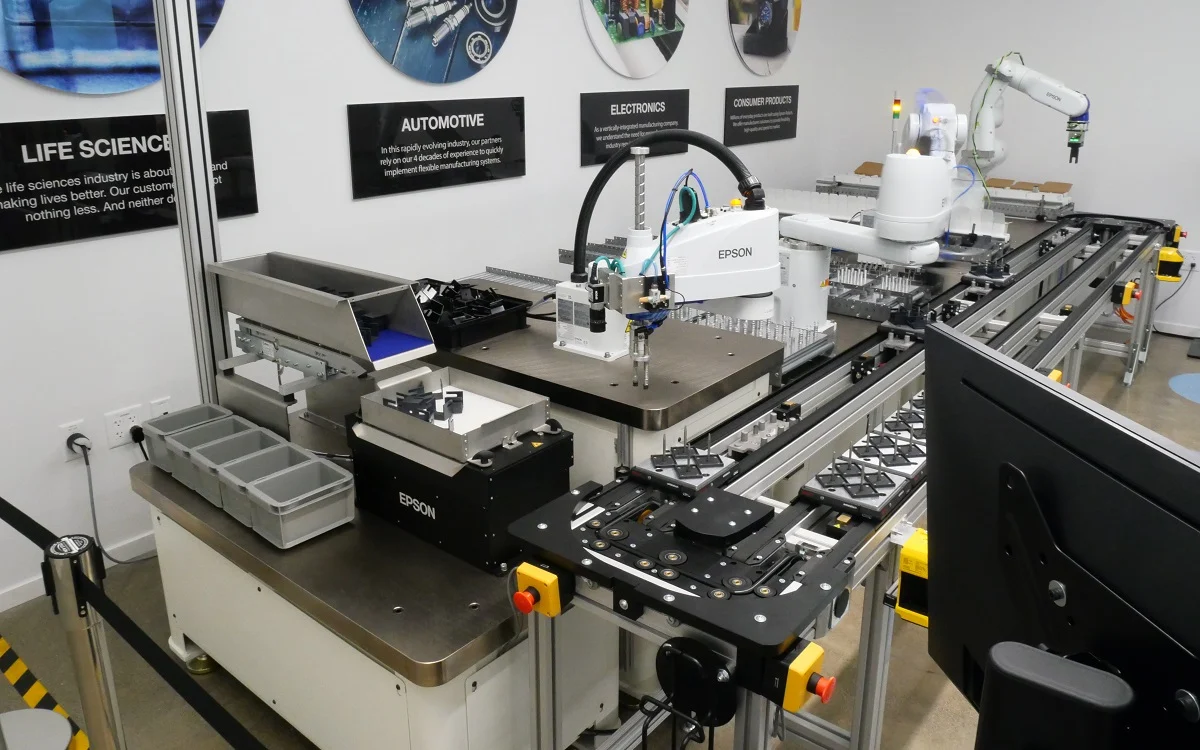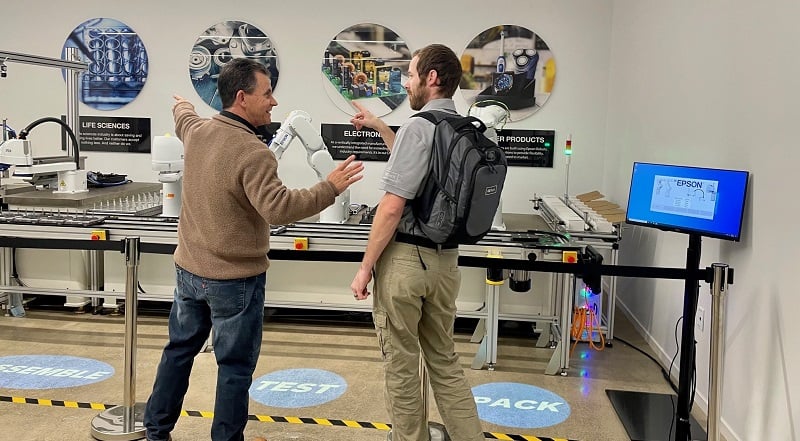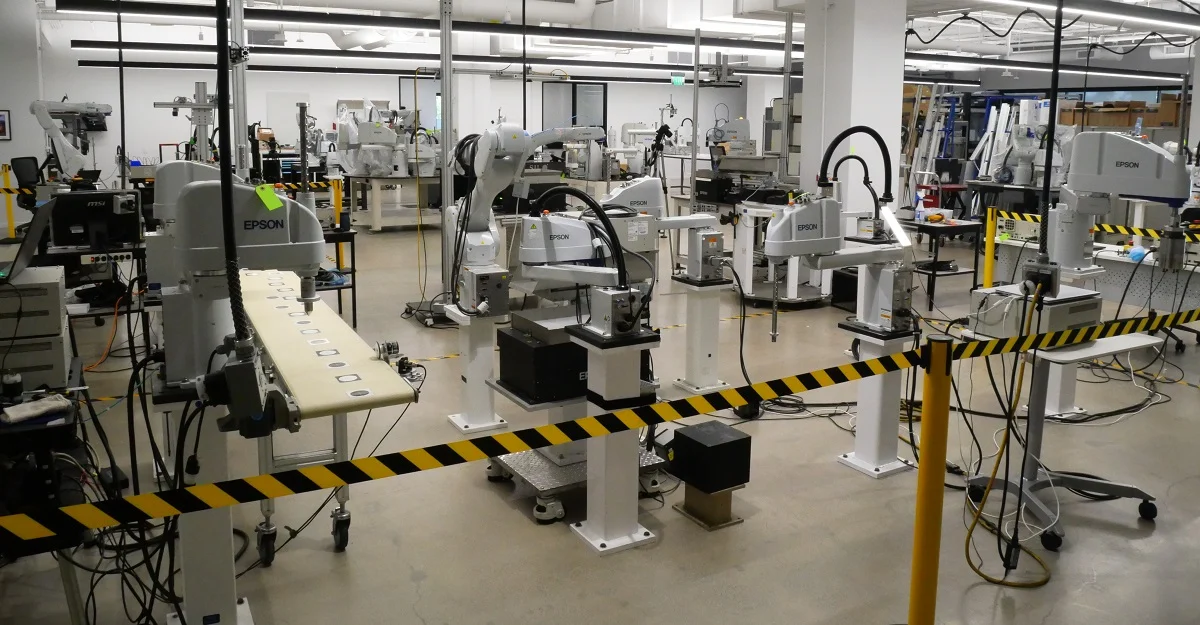Recently, the Control.com engineering team had the opportunity to visit the R&D demo lab facility for the robotics division of Epson, located in Los Alamitos, CA. Come learn how the magic happens!
The answer lies hidden behind the doors of the R&D facilities of robot manufacturers, where so many exciting projects take place, from the testing of new concepts and ideas to the formatting of custom processes to work with each unique customer. And that doesn’t even include the service and repair projects that also sometimes (inevitably) happen behind the scenes.
Epson Robots: The High-Speed SCARA Experts
Epson, although known to much of the world for its catalog of printers, scanners, and projectors, has been manufacturing industrial robots for decades, perfecting motion control techniques through its flagship SCARA lineups, specialized for ultra high-speed applications.
So, why is ‘ultra high-speed’ such a big deal here, I mean, all robots are fast, right? For some tasks, particularly those with bulky or heavy payloads, the robot simply cannot travel too quickly without risk of damage to the product or equipment nearby. Precise control is still necessary, but motor torque is valued over joint speed.
For other applications (to name a few: populating PCBs in the electronics/semi industry, life sciences and biotechnology, lab automation, etc.), the parts are tiny, and the cycle times must be extremely low. This means that the movement speed of the robot can be extremely high.
Figure 1. Inside the Epson demo room, a series of robots coordinate motion to accomplish a series of tasks, each appropriate for its model. Image used courtesy of the author.
SCARA robots excel at pick-and-place applications, moving parts along a single horizontal plane, but the increased speed and precision come with some challenges. The weight of the robot and the subtle change in payload and TCP position create ever-changing inertial moments, which can introduce offset and oscillation in settling points. Those are common terms in the motion control industry, but not so much in industrial robots.
Epson tackles this challenge with a combination of hardware, with in-house produced quartz crystals that are used as the basis of multi-axis gyroscope sensors, along with the GYROPLUS software to provide a feedback loop (think PID control, for you motion experts) to constantly project a correct motion path while maintaining extremely high speeds.
Robot Coordination: 6-Axis and SCARA Work Cells
Epson does not exclusively produce SCARA robots, even though these devices do yield some of the most impressive demonstrations. An extensive lineup of 6-axis robot arms adds flexibility to a manufacturing and packaging line.
When working with multiple task stations, consider how each station performs its job. One station might use vision and bin-picking to select a product and place it on a conveyor or add it to an assembly. With part orientation being a major concern, the planar motion of the SCARA might not be appropriate. However, if the parts are served in a consistent hopper or on another infeed conveyor, the 6-axis arm might consume unnecessary footprint space.
At the Epson facility, this is demonstrated for the benefit of potential customers and anyone wishing to visualize the overall process of many robots working together to create and package a small item. I was fortunate enough to see the entire cell demo, thanks to a tour guided by Senior Manager of Application Engineering Phil Baratti, Product Manager Scott Marsic, and Senior Applications Specialist Frank Habib, all experts in the entire Epson robotics lineup.
Figure 2. Phil Baratti (left) guides author David Peterson of Control.com through the demonstration of the multi-robot demo assembly cell. Image used courtesy of Epson.
The Peripherals: Automation Outside of the Robot
The robot may perhaps be the most expensive part of a work cell, but it’s certainly not the most important. In other words, without the rest of the automation working properly, the robot cannot be expected to perform well. The Epson demonstration underscores the importance of this surrounding automation. In the video above, the vibratory feeder and overhead vision are clearly visible, ensuring that the SCARA robot is presented with an oriented part.
The pallets providing motion must be carefully controlled and monitored so that no stage becomes a bottleneck. Raw materials entering, as well as the final package exiting, are both aligned perpendicularly to maximize efficiency. Obviously, not every process can make use of the same variables, but it highlights the attentiveness to not only the performance of the robot, but how well it ‘plays’ with the remainder of the process. Without production, there is no ROI.
Figure 3. Each of four stations used by Epson to demonstrate feeding, assembling, and packaging of a widget. Inspection is also included (although accomplished with internal force sensors) in the third stage. Video used courtesy of the author.
Epson Lab: Research and Development
Demonstrating the capabilities of a current robot model is only half the picture. Behind the next set of doors, the robotic experts must consider the future needs of customers, as well as design the tooling and programming solutions unique to each company’s product or process.
Figure 4. A room filled with almost 100 robots being used for research, development, and servic projects. Image used courtesy of the author.
The R&D facility accomplishes this task while, at the same time, providing a staggeringly impressive look at the wide variety of robots in the Epson catalog, many being tasked with special projects, service and upgrades, repair, and a host of other needs. Any room that can be filled with this many robots holds a special place in the heart of any automation engineer.
Seeing is Believing
In automation, we have learned not to trust the first impression of internet videos, or to read a quick sales brochure and make a major purchasing decision. Instead, we trust the advice of actual, practical demonstrations that show how our unique requirements can be met most efficiently and realistically with tried-and-true technology.
Touring the Epson robotics facility was only a brief glance into the capabilities of this automation technology, but it’s easy to visualize any process customized and configured with the help of experts who understand the robots, the peripheral equipment, and your unique industry.
This article was written by David Peterson from Control.com
![]()




